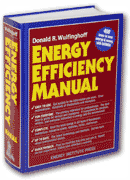Overview of…
5.5 Split System Air Conditioning Units and Heat Pumps
This part of the Energy Efficiency Manual explains how to improve the efficiency of split-system air conditioning units and split-system heat pumps. These air conditioning units and heat pumps have outside heat exchangers that are separate from the inside equipment. It does not require large wall or window openings to provide air flow from the outside.
Split system air conditioners most commonly reject heat to the atmosphere through air-cooled condensers. They may also exploit evaporative cooling by rejecting heat through an evaporative condenser or cooling tower. Or, for greater efficiency, they may reject heat to a cooler body of water, such as well water, a lake, or even to the domestic water system.
Split system heat pumps most commonly use the atmosphere as a heat source, by using an outside air coil. Such heat pumps usually require a supplemental purchased energy source during cold weather. For greater efficiency, and to avoid the need for a purchased energy back-up source, heat pumps may draw heat from water sources or from heat exchangers buried in the soil.
Split systems may have a variety of configurations. The four basic components of the vapor compression refrigeration cycle — compressor, condenser, refrigerant metering device, and evaporator — can be grouped in several ways. The grouping of components is based on practical considerations, such as available space, ease of installation, keeping noise outside occupied spaces, etc. Most commonly, the term “split system” means an arrangement with an external package for the compressor and condenser and an internal package for the refrigerant metering device and the evaporator.
The inside equipment may include heating coils, which usually are electric resistance elements. Reliance on electric resistance heaters during colder weather is a major efficiency weakness.
A system may have more than one component of each type. For example, the compressor may serve two or more inside evaporator units. Or, a single cooling tower may cool a water loop that serves any number of packaged room cooling units.
The inside equipment typically discharges conditioned air directly into the space, but some systems may have small ducts.
The energy conservation measures explained here include the equipment maintenance needed to maintain efficiency, use of high-efficiency replacement motors and high-efficiency replacement compressors, optimizing the condenser temperature, turning off crankcase heaters during warm weather, and controls improvements. Major system changes include heat recovery from the condensers and using free energy sources for heating with heat pumps, such as earth source heat pumps.
Click here to return to the Table of Contents


